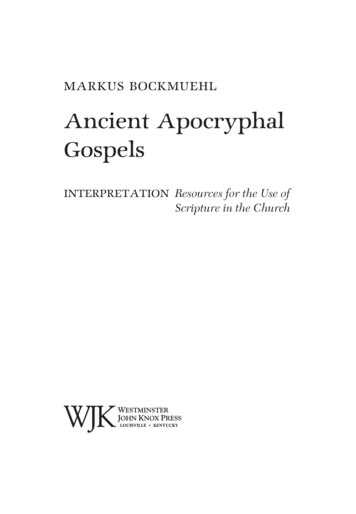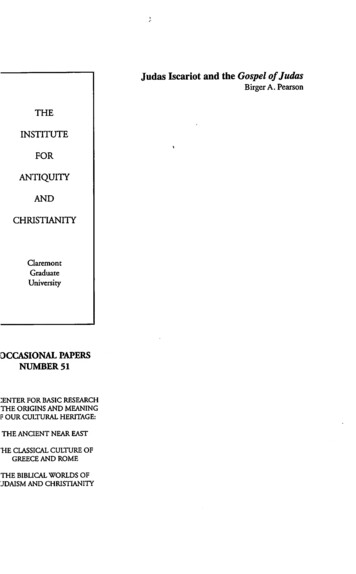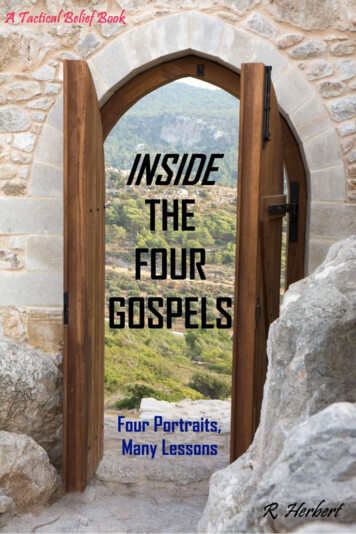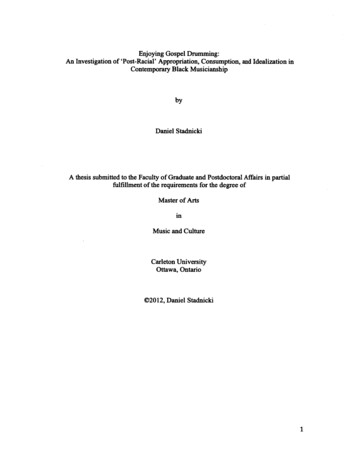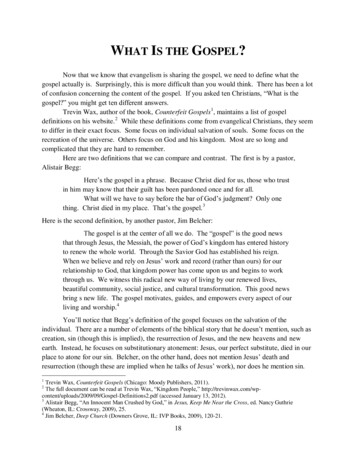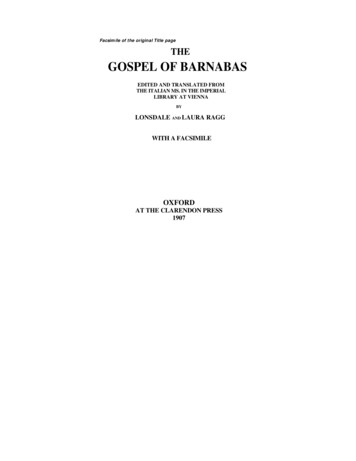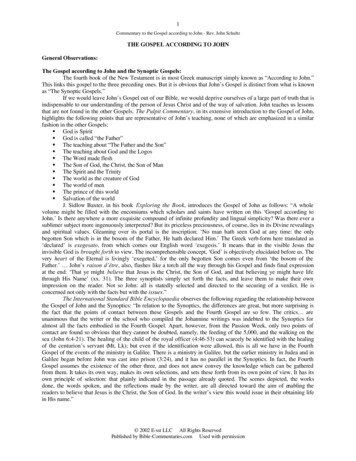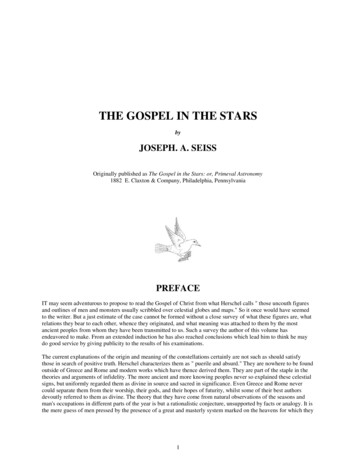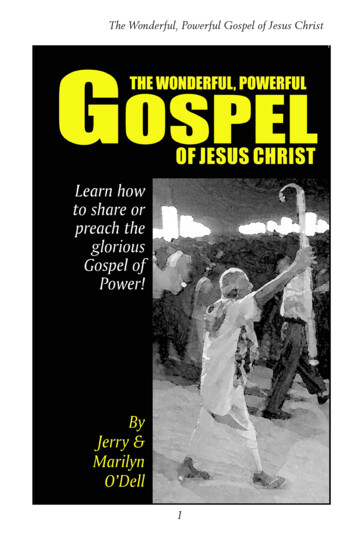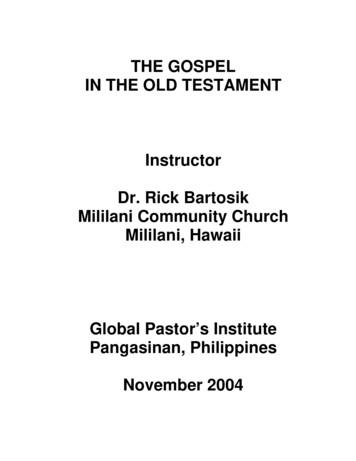
Transcription
THE GOSPELIN THE OLD TESTAMENTInstructorDr. Rick BartosikMililani Community ChurchMililani, HawaiiGlobal Pastor’s InstitutePangasinan, PhilippinesNovember 2004
1LECTURE OUTLINEIt is impossible to clearly and correctly teach the New Testament to believers withoutadequate Old Testament foundations. In this class we will be studying God’s plan ofsalvation as it has been revealed in the prophecy and typology of the Old Testament. Thegoal of these lectures is to encourage you to do more preaching and teaching from the OldTestament Scriptures, and to show you how.I.The First Preaching Of The Gospel – Genesis 3:15 3Genesis 3:15 is called “the protevangelium” – the first preaching of the Gospel.The first preaching of the Gospel took place at the very beginning of human history,immediately after man’s fall in the Garden of Eden. In this verse God promised thatone day he would send a Savior who would destroy Satan and deliver man from hispower. This shows that Jesus has always been God’s only provision for oursalvation; it also shows that the message of the gospel is for the whole world.II.Promises Of Christ’s Coming In The Old Testament . 6Fulfilled prophecy confirms that Jesus is the Messiah and the Son of God who wassent to be the Savior of the world. There are 61 major Old Testament propheciesabout Christ’s first coming that were fulfilled in the New Testament. The place of hisbirth, the time of his birth, the manner of his birth, his betrayal for 30 pieces of silver,the manner of his death, the reaction of people, the piercing of his hands and feet,his burial in a rich man’s tomb, and his resurrection, are just a few of the OldTestament prophecies fulfilled in the life of Christ.III.Portraits Of Christ’s Person And Work In The Old Testament 10Definition of a “Type”: A type is a person, event or thing in the Old Testament thatforeshadows something in the New Testament. Following are some of the maintypes of Christ in the Old Testament Scriptures. These portraits of Christ in OldTestament typology help us understand more clearly the person and work of Christas revealed in the New Testament.1. The Story of Cain and Abel (Genesis 4:4) . 102. The Offering of Isaac (Genesis 22) 133. The Passover Lamb (Exodus 12) . 154. The Tabernacle (Exodus 25-30) . 165. The Five Levitical Offerings (Leviticus 1-7) 176. The Day of Atonement (Leviticus 16) . . 207. The Feasts of Israel (Leviticus 23) 24APPENDIX: Central Passages on the Deity and Incarnation of Christ . 25Dr. Rick BartosikGlobal Pastors InstituteNovember 2004
2INTRODUCTIONTHE BIBLE IS GOD’S REVELATION TO MANThe Bible alone is God’s written revelation of truth to the world. This revelation of Godbegan with the Old Testament and was completed with the New Testament revelation(Hebrews 1:1-2).THE THEME OF THE BIBLEThe central theme of the Bible is Christ. History is HIS-STORY.The Bible reveals that Jesus is the only way to God. To reject Christ as the only way to Godis to reject the Bible as the written revelation of God.THE RELATIONSHIP OF THE OLD AND NEW TESTAMENTSJesus Christ is the key to understanding the Old Testament and the New Testament:The Old Testament is the preparation for ChristThe New Testament is the manifestation of ChristThe Old Testament is the New Testament concealedThe New Testament is the Old Testament revealedA SUMMARY OF THE OLD AND NEW TESTAMENTS:Old TestamentGospelsActsEpistlesRevelation– He is coming!– He is here!– Let’s go tell everyone!– How to get to know Him.– He is coming again!OLD TESTAMENT PROPHECY FORETELLS CHRIST’S COMINGThere are many prophecies in the Old Testament that predict the details of both the first andsecond comings of Christ. The first-coming prophecies were literally fulfilled in history; andwe can expect that the second-coming prophecies will be just as literally fulfilled.OLD TESTAMENT TYPOLOGY FORESHADOWS HIS PERSON AND WORKThere are also many wonderful “types” of Christ in the Old Testament that picture orforeshadow His person and work.Dr. Rick BartosikGlobal Pastors InstituteNovember 2004
3I. THE FIRST PREACHING OF THE GOSPELThe unifying theme of the Old Testament is God’s program of bringing salvation tothe earth. The first preaching of the gospel is found immediately after Adam and Evefell in the Garden of Eden, in Genesis 3:15 (See George Peters, A Biblical Theologyof Missions from which the following material on Genesis 3:15 is adapted).A. THE PLAN OF SALVATION1. Salvation Promised: The Protevangelium (Genesis 3:15)a. This first promise of a coming Redeemer is of tremendous significance.1) This promise was given to the entire human race at the beginning ofhuman history.2) It becomes the guiding star throughout the history and prophecy of theOld Testament until it finds its fulfillment in Christ, the seed of thewoman.3) This verse is the key to understanding that God is the God of allmankind and Christ is the only hope of salvation.b. The meaning of Genesis 3:151) "Satan's seed" consists of those who partake of the character of theAdversary (John 8:44) and seek to oppose God's purposes in creationand redemption.2) The "seed of the woman" refers first to those brought into a rightrelationship with God through faith. It forecasts the age long conflictbetween the children of God and the children of the wicked one(beginning with Cain and Abel).3) The primary "seed of the woman" is the Lord Jesus Christ. It is notthe seed of the serpent but Satan himself who battles and isdestroyed by this Seed (Jesus Christ).4) This verse predicts that Christ would be born of a virgin and wouldengage the Serpent in mortal conflict, finally emerging as victor,destroying the works of Satan and setting the captives free.c. Genesis 3:15 upholds at least six facts:1) Salvation is of God. He is mankind's only hope. He is the source,originator, initiator and procurer of salvation. This refutes humanism,the self-redemption of man, and the principle of inevitable progress,especially as it relates to the religious development of mankind.Dr. Rick BartosikGlobal Pastors InstituteNovember 2004
42) Salvation will destroy Satan, the enemy. Thus evil is not a permanentscourge of mankind and this world. God and good will eventuallytriumph. This refutes the theory of dualism and also the cyclicaltheory of history and experience as it underlies most Easternreligions.3) Salvation will affect mankind as a whole; it is broader than only theindividual or a nation. This must not be interpreted to mean that allmen will eventually be saved, for the Bible does not justify such ahope and claim. The fact, however, is that when God's program willbe completed, there will be a reversal in the count; while numerousindividuals will be lost, the race as such will be saved.4) Salvation will come through a Mediator who in an organic way isrelated to mankind. He is of the seed of the woman. This passage isthe only place in the Bible where the term "seed of the woman" isused. Thus the Redeemer will be true man, as Christ indeed was. Hewas real man although not mere man.5) Salvation is bound up with the suffering of the Redeemer; the enemyshall bruise His heel.6) Salvation will be experienced within history as the fall is a part ofhistory. It is as real as the fall is real and as present as the fall ispresent.2. Salvation Pictured (Genesis 3:21)This verse teaches four things:a. Man needed a coveringb. A self-made covering was not good enoughc. God must provide the coveringd. This covering must come through the shedding of blood of an innocentvictimB. THE NEED OF SALVATIONThe first 11 chapters of Genesis leading up to the call of Abraham demonstrateman’s sinfulness and his need for the grace of God. In these chapters we seethe power of sin to debase, corrupt and ruin man when left to himself, and renderhim unable to find God by his own searching. There are four great events inthese chapters: creation, the fall of man, the flood, and the Tower of Babel.1. Entrance of sin: The Fall: Genesis 32. Early development of sin: Cain murders Abel: Genesis 4Dr. Rick BartosikGlobal Pastors InstituteNovember 2004
53. Divine intervention and judgment on sin: The flood: Genesis 6-94. Revival of sin: The Tower of Babel: Genesis 10-115. Culmination of sin: Genesis 11. At this point, God abandons the nations togo their own ways. He lifted the restraints and allowed the nations to go theirown ways and design their own cultures and their own religions. A deepdarkness settled upon mankind. Romans 1:18ff is the theologicalinterpretation of the Tower of BabelC. THE METHOD OF SALVATIONThe world had turned from God and God turned from the nations to call one manthrough whom He would carry out His great plan to send the Savior to redeemthe world from sin. That man was Abraham.Genesis 12:1-3: The Call of Abraham. “I will bless those who bless you, andwhoever curses (qalal) you I will curse (aror); and all peoples on earth will beblessed through you."1. Two different Hebrew words are used here for curseQalal "to treat indifferently, lightly, to despise"Aoor "to make sterile, to damn"2. The promise of Genesis 12:1-3 ultimately fulfilled in the Lord Jesus ChristHebrews 10:29Galatians 3:10,13Dr. Rick BartosikGlobal Pastors InstituteNovember 2004
6I.PROMISES OF CHRIST’S COMING IN THE OLD TESTAMENTA. INTRODUCTIONThe identity Of Jesus Christ is crucial to understanding everything he had to say. Allthat Jesus said and did pointed to his identity as the Messiah, the Son of God, and tothe purpose for which he came to earth. If Jesus is not who he claimed to be, thenhis teachings are either the ramblings of a lunatic who sincerely thought he was God(but wasn’t) or the words of a liar who knew he wasn’t God (but said he was).One of the major evidences to support Christ’s claim to be the Messiah, the eternal,incarnate Son of God, are the great messianic prophecies of the Old Testament (Theother major evidences are his virgin birth and his miracles).The fulfillment of all the messianic prophesies in one person, Jesus Christ, providesconvincing proof that Jesus Christ is indeed the Son of God – the Incarnate Word:”And the word became flesh and dwelt among us; and we beheld his glory, the gloryof the only begotten from the Father, full of grace and truth” (John 1:14).In his book, Beyond Belief To Convictions, Josh McDowell asks us to imagineagreeing over the phone to meet a distant business acquaintance – someone youhave never met in person – at a large business convention (From Beyond Belief toConvictions, 63-68).“How will I know you?” you might ask.“Well,” your associate might suggest, “I’ll be carrying a briefcase.”“All right,” you reply, then think better of it. “A lot of people will probably becarrying briefcases. Not everyone, but a lot. What color is it?”“Black.”“That might narrow it down some,” you say, “but not enough.”“I’m a redhead,” your associate offers.“That helps,” you answer. Redhead carrying a black briefcase. Still might not bespecific enough. “What will you be wearing?”A slight hesitation. “A blue blazer. How’s that?” You nod, though you know yourcolleague can’t see you.“That’s better. But just to be sure, can you wear red tennis shoes?”“Very funny. I’ll just make sure I’m wearing a name tag with my name in big boldletters.”“That should do it,” you answer. I’ll just look for a redhead carrying a blackbriefcase and wearing a blue blazer with a name tag. “I should be able to recognizeyou from a distance, and your name on the tag will seal it.B. RECOGNIZING THE MESSIAHNow imagine God, several millennia ago, devising the plan to send his only Son toearth to be born as a human infant (see Beyond Belief To Convictions, 63-68).If we could have spoken down the corridors of time, we might have asked “How willwe know him? How will we recognize him as the Messiah, the eternalincarnate Son of God?”Dr. Rick BartosikGlobal Pastors InstituteNovember 2004
7God might have responded, “I will cause him to born as an Israelite adescendant of Abraham (Genesis 22:18; Galatians 3:16).”“But,” we might have protested,” Abraham’s descendants will be as numerous asthe stars!”“Then I will narrow it down to only half of Abraham’s lineage and make him adescendant of Isaac, not Ishmael (Genesis 21:12; Luke 3:23-34).”“That will help but isn’t that still an awful lot of people?”“Let him be born from Jacob’s line, then, eliminating half of Isaac’s lineage(Numbers 24:17; Luke 3:23-34).”“But—““I will be more specific. Jacob will have twelve sons; I will bring forth the Messiahfrom the tribe of Judah (Genesis 49:10; Luke3:23-33).”“Won’t that still be a lot of people? We still may not recognize him when hecomes.”“Don’t worry! Look for him in the family line of Jesse (Isaiah 11:1; Luke 3:2332). And from the house and lineage of Jesse’s youngest son, David (Jeremiah23:5; Luke 3:23-31). And then I will tell you where he will be born: Bethlehem, a tinytown in the area called Judah (Micah 5:2; Matthew 2:1).”“But how will we know which person born there is your Son?”“He will be preceded by a messenger who will prepare the way and announcehis advent (Isaiah 40:3; Matthew 3:1-2). He will begin his ministry in Galilee(Isaiah 9:1; Matthew 4:12-17) and will teach in parables (Psalm 78:2; Matthew13:34-35), performing many miracles (Isaiah 35:5-6; Matthew 9:35).”“Okay, that should help a lot.”“Oh,” God might have responded “I’m just getting warmed up. He will ride intothe city of Jerusalem on a donkey (Zechariah 9:9; Matthew 21:2; Luke 19:35-37)and will appear suddenly and forcefully at the temple courts and zealously ‘cleanhouse’ (Psalm 69:9; Malachi 3:1; John 2:15-16). In one day I will fulfill no fewerthan twenty-nine specific prophecies spoken at least five hundred years earlierabout him!” Listen to this:1. He will be betrayed by a friend (Psalm 41:9; Matthew 26:49).2. The price of his betrayal will be thirty pieces of silver (Zechariah11:12; Matthew26:15).3. His betrayal money will be cast to the floor of my temple (Zechariah 11:13;Matthew 27:5).4. His betrayal money will be used to buy the potter’s field (Zechariah 11:13;Matthew 27:7).5. He will be forsaken and deserted by his disciples (Zechariah 13:7; Mark 14:50).6. He will be accused by false witnesses (Psalm 35:11; Matthew 26:59-60).7. He will be silent before his accusers (Isaiah 53:7; Matthew 27:12).8. He will be wounded and bruised (Isaiah 53:5; Matthew 27:26).9. He will be hated without a cause (Psalm 69:4; John 15:25).Dr. Rick BartosikGlobal Pastors InstituteNovember 2004
810. He will be struck and spit on (Isaiah 50:6; Matthew 26:67).11. He will be mocked, ridiculed, and rejected (Isaiah 53:3; Matthew 27:27-31: andJohn 7:5,48).12. He will collapse from weakness (Psalm 109:24-25; Luke 23:26).13. He will be taunted with specific words (Psalm 22:6-8; Matthew 27:39-43).14. People will shake their heads at him (Psalm 109:25; Matthew 27:39).15. People will stare at him (Psalm 22:17; Luke 23:35).16. He will be executed among “sinners” (Isaiah 53:12; Matthew 27:38).17. His hands and feet will be pierced (Psalm 22:16; Luke 23:33).18. He will pray for his persecutors (Isaiah 53:12; Luke 23:34).19. His friends and family will stand afar off and watch (Psalm 38:11; Luke 23:49).20. His garments will be divided and won by the casting of lots (Psalm 22:18; John19:23-24).21. He will thirst (Psalm 69:21; John 19:28).22. He will be given gall and vinegar (Psalm 69:21; Matthew 27:34).23. He will commit himself to God (Psalm 31:5; Luke 23:46).24. His bones will be left unbroken (Psalm 34:20; John 19:33).25. His heart will rupture (Psalm 22:14; John 19:34).26. His side will be pierced (Zechariah 12:10; John 19:34).27. Darkness will come over the land at midday (Amos 8:9; Matthew 27:45).28. He will be buried in a rich man’s tomb (Isaiah 53:9; Matthew 27:57-60).29. He will die 483 years after the declaration of Artaxerxes to rebuild the temple in444 B.C. (Daniel 9:24).As a final testimony, on the third day after his death, he will be raised form the dead(Psalm 16:10; Acts 2:31), ascend to heaven (Psalm 68:18; Acts 1:9), and be seatedat the right hand of God in full majesty and authority (Psalm 110:1; Hebrews 1:3).What extraordinary lengths God went to in order to help people identify andrecognize his only begotten Son! Jesus fulfilled sixty-one major Old TestamentDr. Rick BartosikGlobal Pastors InstituteNovember 2004
9prophecies (with about 270 additional ramifications) – all of which were made morethan 400 years before his birth.C. THE PROBABILITY FACTORIs it possible to believe that some of the details of Jesus’ life just happened tocoincide with all those Old Testament prophecies? Peter Stoner in an analysis thatwas carefully reviewed by the American Scientific Affiliation (quoted in Evidence ThatDemands A Verdict, 167) used the modern science of probability to show that thechance that any man might have lived down to the present time and fulfilled just eightof these major prophecies is 1 in 10 17. That would be 1 in 100,000,000,000,000,000.In order to help us comprehend this staggering probability, Stoner illustrates it bysupposing that we take 1017 silver dollars and lay them on the face of Texas. Theywill cover all of the state two feet deep. Now mark one of these silver dollars and stirthe whole mass thoroughly, all over the state. Blindfold a man and tell him that hecan travel as far as he wishes, but he must pick up one silver dollar and say that thisis the right one. What chance would he have of getting the right one? Just the samechance that the prophets would have had of writing these eight prophecies andhaving them all come true in any one man, from their day to the present time,providing they wrote them in their own wisdom. Yet not just eight prophecies, but all61 major prophecies, came true in Christ. This shows that these prophecies aboutChrist’s coming were given by inspiration of God. They were fulfilled in Christ toprove to us that Jesus is indeed the eternal Son of God and the Savior of the world.D. THE MOST POWERFUL OF ALL MESSIANIC PROPHECIESThe most explicit and powerful of all messianic prophecies is Isaiah 52:13-53:12. Itwas written seven centuries before the birth of Christ. It reveals that:The Messiah would suffer sinlessly (53:4-6, 9).The Messiah would suffer silently (53:7).The Messiah would die as a substitute to bear the sins of others (53:5-6, 8, 10-12).The Messiah would be subject to “scourging” “pierced through” “cut off out of theland of the living.”The Messiah would be buried in a rich man’s tomb (53:9).The Messiah would be resurrected (53:11).The Messiah would justify those who believe in him (53:11).What a clear portrait of the rejection, death, burial, and resurrection of Jesus!(Note: The charts on the following two pages are from The Moody Handbook of Theologyby Paul Enns).Dr. Rick BartosikGlobal Pastors InstituteNovember 2004
10Dr. Rick BartosikGlobal Pastors InstituteNovember 2004
11Dr. Rick BartosikGlobal Pastors InstituteNovember 2004
III. PORTRAITS OF CHRIST IN THE OLD TESTAMENTA type is a person, event or thing in the Old Testament that foreshadows somethingin the New Testament. Following are some of the main types of Christ in the OldTestament Scriptures. These portraits of Christ in Old Testament typology help usunderstand more clearly the person and work of Christ as revealed in the NewTestament.1.THE STORY OF CAIN AND ABEL (Genesis 4)“In the course of time Cain brought some of the fruits of the soil as an offering to theLORD. But Abel brought fat portions from some of the firstborn of his flock. TheLORD looked with favor on Abel and his offering, but on Cain and his offering he didnot look with favor. So Cain was very angry and his face was downcast” (Genesis4:3-5).INTRODUCTIONCain and Abel were both born outside of the Garden of Eden, after the fall recordedin Genesis 3. They were sinners because of their father Adam (Romans 5:12). Theywere separated from God and could not escape the judgment of God unless GodHimself did something to save them.God had instructed man that if he wished to approach God, he must take a lamb andkill it. Its blood had to be shed to remind the offerers that they deserved to die andthat only God could save them. Their faith had to be in God, not in themselves oranything that they could do.1.Cain refused to come God’s way and was therefore rejected.2.Abel came God’s way, trusting in God’s mercy and promises and wasaccepted.3.Abel responded by faith to God’s revelation.4.Cain rebelled against God’s revelation.5.Cain represents the “natural man.” The natural man is one who rejects thework of Christ on the cross and thinks he can obtain salvation by his ownworks.6.Abel represents the “spiritual man”. He represents the one who trusts in thefinished work of Christ on the cross as his only hope of salvation.7.The difference was not in their natures but in their offerings. There is nothingto indicate that at the beginning Cain was a worse man than Abel. He was notan atheist. He acknowledged the existence of God. He was prepared toworship God – but in his own way.
138.Cain’s offering was bloodless. It was the product of his own labors, the fruit ofthe ground. It pictured human works.9.Abel brought a bleeding sacrifice, picturing the sacrifice of Christ.10.In bringing his offering Cain deliberately turned his back on God’s revealed will.He ignored the demand of God for forgiveness by the death of a substituted.He insisted on approaching God on his own terms.11.“The way of Cain” spoken of in the Book of Jude is the way of self-will, unbelief,disobedience and religious hypocrisy. It is a way that denies that man is asinner and separated from God. It denies that man’s nature is essentially evilsince the fall that that except a man be born again he cannot see the kingdomof God.12.Cain represents those who rely on their own goodness and morality. Abelrepresents those who rely upon the precious blood of Christ.CAIN’S STEPS DOWNWARD1.Anger – He was angry that he could not approach and worship God in his ownway. Unless illumined by the Holy Spirit the human heart rebels against theimpossibility of approaching God except through a substitutionary sacrifice.2.Warned by God – “sin is crouching at your door ”3.Refused to repent – continued in the way of self-will and rebellion.4.Murdered Abel – After church he went out and killed Abel5.Lied to God – “Am I my brother’s keeper?”6.Went off from the presence of the LORD –CAIN AND ABEL PICTURE THE TWO GREAT GROUPS OF HUMANITY1.Cain represents those who are lost. They rely on their own goodness. The lineof Cain line was devoted to the things of this earth. Cain built a city, madegreat progress. The line of Cain was involved in music, the arts, metallurgy,and domestication of animals. But they lived apart from God. They were alsocharacterized by sexual immorality and violence. This whole line wasultimately destroyed in the flood.2.Abel represents those who are saved by resting on the finished work of Christ.He represents those who are accepted and blessed by God.3.Cain represents those who insist on salvation by human merit. He representsthose who are rejected and cursed by God.4.The remainder of chapter 4 traces the godless line of Cain down to the 7thgeneration and then closes with an account of the birth of Seth – the appointedDr. Rick BartosikGlobal Pastors InstituteNovember 2004
14successor of Abel and the one from whom the chosen race and the Messiahwould come.THE DEVELOPMENT OF THE UNGODLY LINE OF CAIN AND THE GODLY LINEOF SETH1.We see the rapid development of sin in the life of Cain.a. Cain kills Abel – murder in the second generation after the fallb. Cain denies the act, is defiant, and repudiates any obligation to his brother;then after God’s sentence is more concerned with the consequences of hissin not the sin itself.c. We then see human progress: agriculture, musical instruments, metallurgy.But they are living without God – totally devoted to earthly things.Destroyed in the flood.2.The seventh from Adam through Cain was Lamech. He was an arrogant andimmoral man and a murderer.3.The seventh from Adam through Seth was Enoch. He walked with God,witnessed to his generation, and “was not” because God took him. He did notexperience the judgment of the flood.4.In Genesis 6 we see the blending of these two lines through intermarriageculminating in the judgment of the flood.ABEL A TYPE OF CHRISTThe word “blood” is first mentioned in the Bible in this chapter. It speaks of innocentblood shed by wicked hands. Thus Abel is a type of Christ. His murder foreshadowsour Lord’s rejection and crucifixion.Dr. Rick BartosikGlobal Pastors InstituteNovember 2004
152.THE OFFERING OF ISAAC (GENESIS 22)ISAAC AS A TYPE OF CHRIST1. This chapter has been called a love chapter, because it tells the story of the loveof a father for his only son and his willingness to offer his son to God as asacrifice.2. Throughout the history of the church, Abraham's sacrifice of his only son Isaachas been seen as a miniature picture of God's love for us in giving His onlybegotten Son as a sacrifice for our sins.3. And Isaac's obedience to his father and trust in him has been understood toillustrate the perfect obedience of Jesus Christ to the will of God the Father.Philippians 2:8 says Jesus became "obedient to the point of death, even deathon a cross."4. God's call at the last minute and His provision of a ram in verse 13, is anillustration of the resurrection of Isaac from the dead. SEE HEBREWS 11:17-19.Isaac rose from the dead "figuratively speaking," but Jesus Christ truly rose againfrom the dead.ABRAHAM'S SACRIFICE OF ISAAC ON MOUNT MORIAH (22:2)"Take your son, your only son Isaac, whom you love and go to the region ofMoriah. Sacrifice him there. . . . ."1. This is the first time love is mentioned in the Bible. Notice that the first time loveis ever mentioned in the Bible, it is not the love of a man for his wife, or the loveof a mother for her children, or even a man's love for God. It is the love of afather for his son. And it is used in connection with a sacrificial offering of thatonly and beloved son.This is a picture of God the Father and God the Son. Isaac is a type of Christ.The love of Abraham for Isaac is a miniature picture of the love of God the Fatherfor God the son. And Abraham's offering of Isaac is a picture of the offering Godwould one day make of His own beloved Son.The first occurrence of love in the NT is Matt. 3:17: "This is my beloved son inwhom I am well pleased." The first occurrence of love in the Gospel of John isJohn 3:16: "God so loved the world that he gave. . ."2. This event took place in the "region of Moriah." II Chronicles 3:1 makes it clearthat many centuries later it was be in this very place that Solomon's Temple wasbe built. And then, many centuries after the time of Solomon, the Lord Jesushimself was sacrificed and died in this same place where Abraham offered Isaac.Abraham did not hold back his most precious treasure from God. And Romans8:32 says God did not spare his Son, but delivered him up for us all. Abraham'soffering is a picture of God's redeeming love for us in Christ.Dr. Rick BartosikGlobal Pastors InstituteNovember 2004
16THE SACRIFICE OF ISAAC WAS A BURNT OFFERING (22: 2,3,6,7,8,13)1. Under the Old Testament law recorded later in Leviticus, there were to be sevensacrifices. Each of these sacrifices was a kind of "visual aid" to help the peopleof God appreciate the many aspects of the work of Jesus Christ on the cross.One of these seven sacrifices was the burnt offering.2. The SIN OFFERING and the TRESPASS OFFERINGS represented the aspectof forgiveness for sins committed. But the BURNT OFFERING emphasized totalconsecration to God. The burnt offering was to be offered voluntarily. And it wasto be offered whole. Nothing was to be kept back.3. So when Abraham offered Isaac as an act of worship, he was totally giving Isaacto God. He was freely and trustingly offering back to God, what God had given tohim.4. At the same time Isaac consecrated his life to God. Isaac could have refused tosubmit to be bound and laid upon the wood. But Isaac lovingly submitted to hisfather's obedience to God.5. The Bible says that Christ did the same. Ephesians 5:2: "Be imitators of God,therefore, as dearly loved children and live a life of love, just as Christ loved us agave himself up for us as a fragrant offering and sacrifice to God."6. Jesus fulfilled what was symbolized in the burnt offerings when he offeredhimself as a "burnt offering" to God in our place. This can also be applied to ourconsecration to God. READ Rom. 12:1-2.WHEN ABRAHAM OFFERED ISAAC GOD PROVIDED A RAM IN HIS PLACE(22:11-14)1. “The Lord will provide.” Provide what? Provide a sacrifice.2. Two thousand years later someone else carried the wood of sacrifice up the hillof Calvary. He was born to die for our sins.3. God stopped Abraham before Isaac could be sacrificed. But when our Lordclimbed Moriah, God's hand was not stopped. God provided the sacrifice inChrist for our greatest need.Dr. Rick BartosikGlobal Pastors InstituteNovember 2004
173. THE PASSOVER LAMB (EXODUS 12)What the Passover Lamb was to Israel, Jesus Christ is to us“Christ our Passover is sacrificed for us” (I Corinthians 5:7). "Behold the Lamb ofGod who takes away the sin of the world" (John 1:29)A.The Sacrifice Of The Lamb (1-7)—a picture of our salvation1.2.3.4.B.Supply of the Lamb (3-4)a.sufficient for everyone (I John 2:2)b.very precious (Hebrews 10:29Standard of the Lamb (5-6)a.perfect (I Peter 1:18)b.provenSlaying of the Lamb (6)a.time (Matthew 27:45-46, 50; John 19:31-34)b.method (John 19:36; Psalm 34:19-20)Sprinkling of the blood (7)The Supper Of The Lamb (8-11)—a picture of our sanctification1.The Lamb (8-10)2.Unleavened bread (8)3.Bitter
The fulfillment of all the messianic prophesies in one person, Jesus Christ, provides convincing proof that Jesus Christ is indeed the Son of God – the Incarnate Word: ”And the word became flesh and dwelt among us; and we beheld his glory, the glory of the only begott
